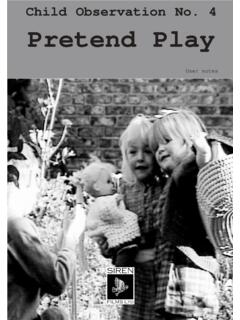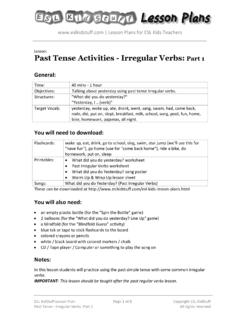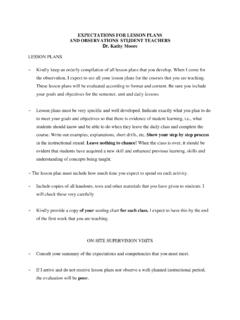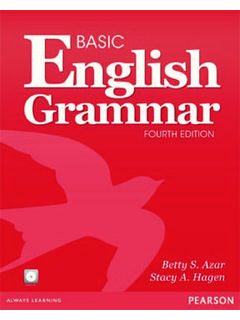Transcription of Learning Spanish: How to Understand and Speak a New …
1 Literature & LanguageTopicLanguage LearningSubtopicCourse WorkbookLearning Spanish How to Understand and Speak a New LanguageProfessor Bill WordenThe University of AlabamaPUBLISHED BY:THE GREAT COURSESC orporate Headquarters4840 Westfields Boulevard, Suite 500 Chantilly, Virginia 20151-2299 Phone: 1-800-832-2412 Fax: The Teaching Company, 2015 Printed in the United States of AmericaThis book is in copyright. All rights reserved. Without limiting the rights under copyright reserved above,no part of this publication may be reproduced, stored in or introduced into a retrieval system, or transmitted, in any form, or by any means (electronic, mechanical, photocopying, recording, or otherwise), without the prior written permission ofThe Teaching Worden, Professor of Spanish Director of Spanish Programs The University of AlabamaDr. Bill Worden is an Associate Professor of Spanish and the Director of Spanish Programs in the Department of Modern Languages and Classics at The University of Alabama.
2 Dr. Worden received his in Mathematics from Dartmouth College in 1985 and subsequently taught high school Spanish for five years in Illinois and Massachusetts. After studying in both Vermont and Madrid, he received his in Spanish from Middlebury College in 1996. As a doctoral student at Brown University, Dr. Worden was awarded the David and Ruth Kossoff Prize for Leadership in Language Teaching by the Department of Hispanic Studies and the Presidential Award for Excellence in Teaching by the Graduate School. He also was chosen by fellow graduate students to give the address at the Graduate School commencement ceremony. In 2002, Dr. Worden received his in Hispanic Studies from Brown. Since 2002, Dr. Worden has taught a wide variety of courses at The University of Alabama, ranging from Introductory Spanish and Advanced Grammar and Composition to undergraduate and graduate courses in 16th- and 17th-century Spanish literature.
3 He has directed doctoral dissertations on colonial Latin American literature, early modern Spanish literature, and 20th-century Latin American Worden s main area of research is the work of Miguel de Cervantes, especially his novel Don Quixote. Dr. Worden has published in the fields of early modern Spanish literature, colonial Cuban theater, and 19th-century Spanish literature. He also has published on pedagogical topics, including how to teach Spanish at the middle school and high school levels and how to help undergraduate students make connections to Don Quixote. In addition, Dr. Worden is an award-winning speaker who has lectured on such subjects as the prose of Cervantes, early modern Spanish poetry, and approaches for helping beginning language students become comfortable speaking Spanish. For a number of years, Dr. Worden served The University of Alabama s Department of Modern Languages and Classics as the Director of the Spanish Language Program and was responsible for supervising all graduate teaching assistants and instructors of introductory- and intermediate-level Spanish courses.
4 In 2013, the Alabama Association of Foreign Language Teachers selected Dr. Worden as the winner of the annual Outstanding Foreign Language Teacher Award for Postsecondary. Dr. Laura Rojas-Arce, author of the workbook and coauthor of the speaking activities, grew up in Costa Rica, where she studied psychology as an undergraduate student at the Universidad Hispanoamericana in Heredia. She completed her doctoral studies with a focus on contemporary Central American literature and received her from The University of Alabama in 2013. Dr. Rojas-Arce is an Instructor of Spanish at The University of Alabama, where she teaches courses ranging from Introductory Spanish and Advanced Grammar and Composition to courses on Latin American literature. iiTable of ContentsProfessor Biography ..i Scope ..1 Workbook Introduction ..2 Workbook Families.
5 3 Lesson GuidesLESSON 1 Introduction to the Spanish Language ..4 LESSON 2 Definite Articles and Nouns ..10 LESSON 3 Subject Pronouns and the verb Ser 15 LESSON 4 Regular -ar Verbs in the Present ..21 LESSON 5 Indefinite Articles and Numbers to 100 ..27 LESSON 6 The verb Estar and Numbers over 100 ..33 LESSON 7 Regular -er and -ir Verbs in the Present ..39 LESSON 8 The verb Ir in the 9 Expressing Time in Spanish ..52 LESSON 10 Expressions Using the verb Tener 59 LESSON 11 Verbs like Hacer and Interrogative Words ..66 LESSON 12 The Verbs Saber and Conocer 72 LESSON 13 Stem-Changing Verbs.
6 78iiiTable of ContentsLESSON 14 Ver, Dar, and Other Irregular Verbs ..83 LESSON 15 The Present Progressive ..89 LESSON 16 Direct Object Pronouns and Adverbs ..95 LESSON 17 Affirmatives, Negatives, and Demonstratives ..101 LESSON 18 More Affirmative and Negative Expressions ..106 LESSON 19 Indirect Object Pronouns ..111 LESSON 20 Double Object Pronouns ..116 LESSON 21 Reflexive 22 Talking about the past : Acabar and Hace 128 LESSON 23 Talking about the past : Desde Cu ..133 LESSON 24 Formal Commands and Unequal Comparisons ..138 LESSON 25 Informal Commands ..142 LESSON 26 Superlatives and Equal Comparisons ..149 LESSON 27 Regular -ar Verbs in the Preterite ..153 LESSON 28 Regular -er and -ir Verbs in the Preterite ..157 LESSON 29 Irregular Verbs in the 30 Next Steps in Improving Your Spanish.
7 166ivLearning Spanish: How to Understand and Speak a New LanguageSupplemental Material Grammar Reference ..172 Los glosarios / The Glossaries ..178 Glosario por tema / Glossary by Topic ..180 Glosario de cognados / Glossary of Cognates ..196 Glosario espa ol-ingl s / Spanish-English Glossary ..202 Glosario ingl s-espa ol / English-Spanish Glossary ..219 Resources for Further Study ..236 Photographic Credits ..2381 ScopeThis course introduces learners to the Spanish language and the cultures of the Spanish-speaking world. Because the course is designed for learners with no previous experience with the language, the lessons begin with the building blocks of Spanish: the alphabet, the proper pronunciation of consonant and vowel sounds, and greetings and responses to greetings. As you move forward in the course, you will be introduced to a variety of fundamental grammar topics, ever-increasing vocabulary lists, and cultural information that will teach you about the countries in the world where Spanish is spoken and help you Understand how to use the grammar and vocabulary you will learn about in their proper cultural context.
8 The purpose of this course is not simply to teach you about Spanish, but rather to develop your language skills so that you can communicate successfully in the language. For that reason, the course includes a variety of components designed to allow you to practice and improve your abilities in reading, writing, speaking, and understanding spoken Spanish. This course exposes learners to a variety of cultural aspects in the Spanish-speaking world, both in the video lessons and in the Cultural Readings that are found in the workbook. In terms of the grammar and vocabulary presented in the 30 lessons, this course covers the equivalent of what is taught in a first-semester Spanish course in college. You will find extensive grammar and vocabulary information in the various sections of the workbook. In addition, you might wish to consult any standard introductory Spanish textbook for reference.
9 Throughout the course, you will learn more than a thousand of the most commonly used words in Spanish and become acquainted with a number of important cultural aspects of the Spanish-speaking world. In terms of grammar, you will learn how to form the present tense of all verbs, as well as the present progressive construction, which is used to talk about something happening right now. You will be able to talk about future events in two different ways and to use several expressions that talk about past events. Moreover, you will learn how to conjugate and use one past tense the preterite tense for all verbs. Your ability to express yourself with verbs will be accompanied by a growing competence in using, for example, nouns, adjectives, and adverbs all the necessary linguistic tools that will allow you to communicate successfully in Spanish.
10 This course offers the requisite linguistic and cultural knowledge that will allow you to make the necessary first steps toward achieving communicative competence in Spanish. 2 Workbook IntroductionWelcome to the workbook for Learning Spanish: How to Understand and Speak a New Language. The exercises included here are designed to help develop your reading and writing skills in Spanish while you practice the vocabulary and grammar presented in the lessons. This introduction briefly explains how this workbook fits in with the other components that accompany this course so that you ll know how best to make use of all of them to help develop your Spanish you finish watching one of the 30 lessons, you should next listen to the audio glossary, which will give you the pronunciation and definition of all the new vocabulary words. Then, it will be time to practice what you ve learned.







